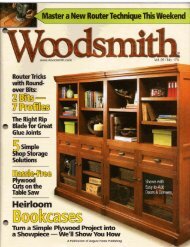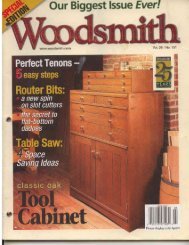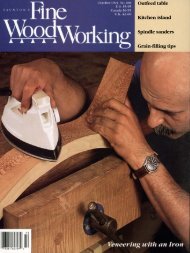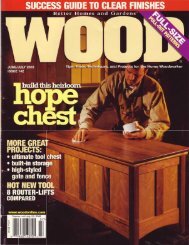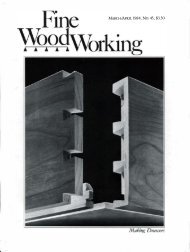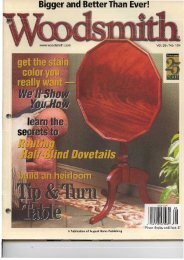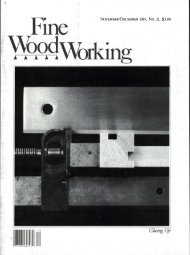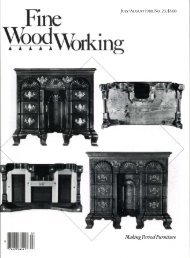Untitled - MetosExpo - Free
Untitled - MetosExpo - Free
Untitled - MetosExpo - Free
You also want an ePaper? Increase the reach of your titles
YUMPU automatically turns print PDFs into web optimized ePapers that Google loves.
.Bird's-Eye MapletUTe JItIlunts her 'Midas touch'Collecting and stockpiling interesting woods for pet projectsis characteristic of woodworkers, and I'm no exception. Ihave a particular soft spot for bird's-eye maple. Once a lumberdealer steers me to d1e yard's maple staSh, I quickly find myselfout of control and reaching for my checkbook. But what is themystique about bird's-eye maple mat turns woodworkers intowood worshippers ? It may be its golden-grain beauty and rarity, orit may be mat nobody can explain how the eyes form. Like a jewelscattering light, mis unique wood provides few clues to me mysteriousprocess that forged it.The distinctive figure, named for the way each tiny swirl resemblesme eye of a bird, is usually found in me sugar or hard mapleCAcer saccharum), one of Norm America's most distinctive trees,known for its shade, cream-color lumber and sticky harvest of sap.The bird's-eye figure can be found wherever maples grow, but it'smost common in me harsh growing conditions of me north country.Occasionally it's found in omer wood species, including soft maple,yellow birch, ash and ponderosa pine. Whatever the cause ofd1e figure, it's a result that woodworkers prize. When a bird's-eyelog is split along a plane tangent to the growd1 rings, the woodseparates, exposing a bulging cone that extends inward on mebark-facing side of the wood and a matching pit on me log's omerside. When a log is sliced lengthwise or rotary-cut for veneer, theresult is me familiar bird's-eye pattern.Individual eyes can be as tiny as pinpricks or me size of a quarter.Once bird's-eyes begin to appear, they propagate, becoming largermrough succeeding outer layers of growth. Often me bird's-eyescontinue to form throughout me life of me tree. Or, they may endabruptly several inches beneath the surface of me log-happy surprisesthat lie in wait for woodworkers.Bird's-eye and other maples have figured prominently in Americanwoodworking and furniture history. I'll tell you a little about itbefore discussing what we know about bird's-eye formation andd1e practical aspects of how to work wim it.Bird's-eye history-American furnituremakers have used bird'seyeveneer for more than two centuries. Almough little has beenrecorded about its use, early furnituremakers often used maple inintricate inlays. In me late 1700s, for example, bird's-eye flourisheswere common on furniture of the Federal period.By the late 19m century, detailed handwork combined wim lavishbird's-eye touches had found its way into art-nouveau furnitureand d1e resurgent Louis XV movement. In the late 1920s, a time oftransition marked by the merging of a new linear functionalismwith ornate traditionalism, me bird's-eye pattern found its niche asa stylistic ornamentation playing counterpoint to the crisp geometryassociated wim design trends such as Art Deco.Virginia Boyd, a University of Wisconsin-Madison historian whospecializes in American interiors, says bird's-eye maple was alsoused at this time for reproduction work-Chippendale and omercolonial-revival pieces. Though seldom used in the originals,bird's-eye, to me 20th-century mind, became associated wim thenostalgic. "It was a hearkening back to an older time and style,even hough it wasn't an accurate look back," Boyd said.Today, bird's-eye maple has found favor as a highly prized speialtywood in the repertoire of many woodworkers. While Europeans,especially Germans and Italians, seem to favor bird's-eye veneer,American woodworkers employ both veneer and solid wood. It'snot unuual in the United States to find furniture made entirely ofsolid bird's-eye maple.Origins-As long as bird's-eye maple has been around, so havequestions about its origin. Why does bird's-eye occur almost exclusivelyin maple ? Why does it appear in such varied patternsmroughout a given tree ? Like random splotches from a frenziedpainter'S brush, bird's-eyes may appear over me entire lengd1 of atree, be confined to one side or scattered in irregular patches.Why, no one knows.Theories about what causes me swirling figure have been as variedas me patterns of the figure itself. Early investigators thought itwas caused by a parasitic fungus dut attacked me cambium, memin layer between bark and wood dut produces new wood cells.Omers suggested it was caused by boring insects, or that woundsinflicted by birds during the tree's early growd1 resulted in pits orgrooves, which over time were fi lled in wim fresh layers of woodgrowm. But these explanations don't make sense, because wounds78 Fine Woodworking



